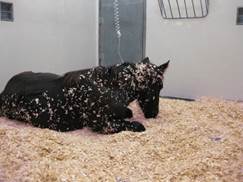Equine - Timely Topics
The Truth About Colic
Patrick Loftin, DVM, Resident, Equine Surgery
 The term “colic” can conjure many frightening images, including expensive surgeries, poor outcomes, and increased likelihood of recurrence. However, colic simply means abdominal discomfort. This can range from very mild, not requiring any specific treatment, to quite severe depending on the cause.
The term “colic” can conjure many frightening images, including expensive surgeries, poor outcomes, and increased likelihood of recurrence. However, colic simply means abdominal discomfort. This can range from very mild, not requiring any specific treatment, to quite severe depending on the cause.
Identifying Colic
Signs of colic can vary drastically, depending on the level of pain and the attitude of the horse. With mild abdominal discomfort, your horse may have less of an appetite or be more lethargic than usual. More specific behaviors would then involve flank watching, posturing to urinate without normal urine output, and intermittent pawing. As pain becomes more severe, pawing may become more constant, the horse may lie down, and may progress to rolling violently. In general, as horses show more severe signs of pain, this means the cause of colic is more serious. However, some horses are quite stoic, and show only mild signs of pain even with a serious colic event.
Most often, horses showing signs of colic have “gas” colic. Large amounts of gas have built up in the gastrointestinal tract and the intestine begins to spasm, or squeeze down, around that gas. Think of it like stomach cramps; they can be fairly uncomfortable but are easily treated. Impactions of feed in the intestinal tract may also occur, and may require more intensive treatment depending on severity. This could include hospitalization and administration of fluids through a nasogastric tube or IV catheter. Some impactions may be severe enough that surgery may become necessary to relieve the blockage. Large colon displacements, where the colon becomes situated in an abnormal area, can obstruct the flow of gas and feed through the intestinal tract but do not cut off blood flow to the intestine. These can cause moderate signs of colic, may be managed medically in some cases, but often require surgery. The most severe causes of colic occur when a piece of intestine becomes twisted or entrapped, and blood flow to that specific area is reduced or stopped. In the small intestine, this can lead to the development nasogastric reflux, where fluid in the intestine backs up into the stomach. This fluid must be removed with a nasogastric tube, as horses cannot vomit, to prevent the stomach from rupturing due to the increased pressure. Moderate to severe pain is usually seen in these cases. When the large colon twists on itself, horses become extremely painful very quickly, and are typically unresponsive to pain medication. For both of these issues, surgery is necessary as soon as possible to resolve the colic.
When to Seek Advanced Care
With this wide range of clinical signs and causes of colic, at what point should you call your veterinarian when you think your horse is colicking? First off, if you are concerned enough to be asking yourself this question, then you should probably go ahead and contact a veterinarian. If you notice mild signs of colic, such as inappetence, and suspect your horse may be beginning to colic, bring them to a confined area so you can monitor them more closely. Watch their attitude, manure output, and any increasing signs of pain. If they continue to act abnormal, especially with no production of manure and/or increasing pain, a veterinary examination is indicated. Initial treatment from your veterinarian, including administration of Banamine as well as water and mineral oil given through a nasogastric, is sufficient treatment for a large majority of colic cases. However, in cases where pain is recurrent or consistent, especially if it becomes severe, hospitalization with further and evaluation and more intensive treatment may become necessary. It is estimated that only 1% of colic cases require surgery, but in these cases getting the horse to a surgical facility as soon as possible can reduce cost, complication rates, and time of hospitalization, and increase survival.
In cases of severe, violent colic, a trip to a hospital is usually necessary. If you are somewhat close to a hospital with surgical capabilities, getting your horse there as quickly as possible is the best course of action. However, if you live multiple hours from the nearest referral hospital, you may want to have your veterinarian see the horse first. With a small intestinal twist or blockage, nasogastric reflux builds up, as we discussed previously. Your veterinarian can pass a nasogastric tube to relieve this pressure, and also administer drugs to relieve pain, for the trip to a hospital. When a long drive is necessary, this can save a horse’s life.
In conclusion, if you notice your horse showing signs of colic don’t panic. As we discussed, a large majority of the time horses respond to simple treatments that can be given on the farm. However, knowing what signs to look for and contacting a veterinarian sooner than later can be extremely beneficial in the long run!